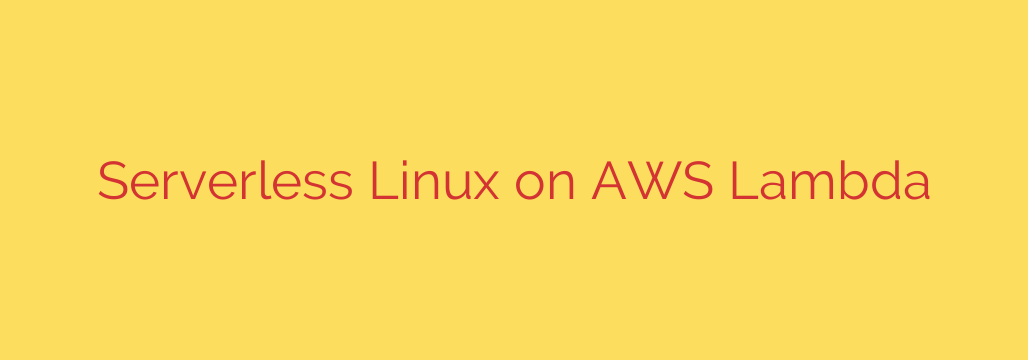
Unleashing the Power of Linux in a Serverless World with AWS Lambda
Serverless computing has revolutionized how developers build and deploy applications, abstracting away the complexities of server management. AWS Lambda stands at the forefront of this movement, allowing you to run code without provisioning or managing servers. While often associated with standard programming language runtimes like Node.js, Python, or Java, a powerful and less obvious capability of Lambda is its underlying foundation: a standard Linux execution environment. This opens the door to running standard Linux executables and leveraging a vast ecosystem of existing command-line tools directly within your serverless functions – essentially creating “Serverless Linux.”
But why would you need to run standard Linux binaries in a serverless function? The reasons are compelling:
- Leverage Existing Tools: Many powerful, well-tested tools are built as Linux command-line executables (e.g.,
ffmpegfor video processing,ImageMagickfor image manipulation,pandocfor document conversion). Instead of reimplementing complex logic in code, you can often package these binaries and call them from within your Lambda function. - Port Legacy Applications: Some older applications or libraries might be easier to package as Linux binaries than to rewrite for a serverless runtime. This allows you to bring existing functionality into a modern, scalable architecture.
- Access System Capabilities: While Lambda restricts direct system calls, including compiled executables can provide access to specific libraries or functionalities not readily available through standard runtime APIs.
How Serverless Linux Works on Lambda
At its core, an AWS Lambda function executes within a secure, isolated container running a version of Amazon Linux (currently Amazon Linux 2). When you upload your function code, you are essentially providing the executable code and any necessary dependencies.
To run standard Linux binaries:
- Package the Executable: You must include the compiled binary of the tool or application you want to run within your Lambda deployment package.
- Include Dependencies: Crucially, you also need to package any shared libraries (.so files) that your executable depends on and are not already present in the standard Lambda execution environment.
- Use AWS Lambda Layers: For managing dependencies, especially larger binaries and libraries, AWS Lambda Layers are highly recommended. Layers allow you to package reusable dependencies separately from your function code, keeping your function package smaller and speeding up deployment. You can create a Layer containing your required Linux binary and its libraries and attach it to your function.
- Execute from Code: Within your function code (e.g., Python, Node.js), you can then use standard mechanisms (like Python’s
subprocessmodule or Node.js’schild_processmodule) to invoke the packaged Linux executable, passing arguments and handling input/output.
Challenges and Considerations
While powerful, running Linux binaries on Lambda isn’t without its challenges:
- Package Size Limits: Lambda has limits on the total size of your deployment package (including Layers). Large binaries and their dependencies can quickly hit these limits.
- Library Compatibility: Ensure the binaries and libraries you package are compiled for the specific Linux environment used by Lambda (Amazon Linux 2). Static compilation can sometimes help reduce dependency issues.
- Ephemeral Storage: Lambda functions have limited, ephemeral storage (
/tmp) available during execution. Any files your binary needs to read or write during execution must fit within this limit and will not persist between invocations. - Cold Starts: Packaging larger binaries and libraries can potentially increase cold start times, as the Lambda environment needs to download and prepare more data before the function can execute.
- Security: Ensure any binaries you include are from trusted sources and are necessary. Minimizing the attack surface is always a good practice.
Actionable Tips for Success
- Minimize Dependencies: Only include the absolute minimum required binaries and libraries. Use tools like
lddon a compatible Linux environment to check dependencies. - Utilize Layers: Leverage Layers for all shared dependencies to improve organization and deployment efficiency.
- Test Thoroughly: Test your function locally (using tools like SAM CLI or Docker) and extensively in the actual Lambda environment to catch compatibility or packaging issues.
- Optimize Binaries: If possible, use optimized or stripped versions of binaries to reduce size.
- Consider Alternatives: Before resorting to including large binaries, evaluate if the task can be accomplished more efficiently using native language libraries or other AWS services.
Running standard Linux executables on AWS Lambda unlocks significant capabilities, allowing you to integrate existing command-line tools and overcome limitations of standard runtimes. By understanding the underlying environment and following best practices for packaging and dependency management, you can effectively harness the power of Serverless Linux to extend the functionality of your serverless applications. It’s a technique that requires careful planning but offers a powerful path for leveraging a wealth of existing software in a modern serverless architecture.
Source: https://kifarunix.com/serverless-computing-with-linux-on-aws-lambda/








